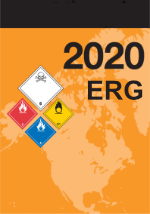UN/NA 1838 |


|
- CAMEO Chemicals has 1 chemical datasheet with response recommendations for this UN/NA number. Response recommendations from the ERG are provided below.
Emergency Response Guidebook (ERG, 2024)
The Emergency Response Guidebook (ERG) provides general response recommendations for first responders.
UN/NA datasheets display several items from the ERG: material names, response guide PDFs, initial isolation and protective action distances, warnings about toxic-by-inhalation gases that may be produced if the material spills in water, and polymerization hazards.
![]() The ERG recommendations are developed for use during the
initial phase of transportation incidents;
they are not intended for spills at facilities.
The ERG recommendations are developed for use during the
initial phase of transportation incidents;
they are not intended for spills at facilities.
Material Names
|

|
|
ERG Table 1: Initial Isolation and Protective Action Distances
| Name of Material | Small Spills (from a small package or small leak) |
Large Spills (from a large package or many small packages) |
||||
|---|---|---|---|---|---|---|
|
First Isolate in all Directions |
Then Protect Downwind |
First Isolate in all Directions |
Then Protect Downwind | |||
| Day | Night | Day | Night | |||
| Titanium tetrachloride (when spilled on land) | 100 ft | 0.1 mi | 0.1 mi | 100 ft | 0.3 mi | 0.3 mi |
| Titanium tetrachloride (when spilled in water) | 100 ft | 0.1 mi | 0.1 mi | 100 ft | 0.2 mi | 0.7 mi |
ERG Table 2: Water-Reactive Materials which Produce Toxic-By-Inhalation Gases
When spilled in water, large amounts of Hydrogen chloride (HCl) may be produced.
Map the ERG's Initial Isolation and Protective Action Distances
Use this tool to see the ERG green table values (above) on a map, and you can also export the map objects as a KML file. See the ERG Distances (PDF) for information on using these values and how they were created.
Set the spill location by typing an address or coordinates into the box in the panel, or by clicking a location on the map. Then use the choices in the panel to provide additional details about the release.
- DAY is between sunrise and sunset.
- SMALL spills are 55 US gallons (208 liters) or less.
- Enter the direction FROM which the WIND is blowing.
- LOW wind is less than 6 miles per hour (less than 10 kilometers/hour), MODERATE wind is 6-12 mph (10-20 km/h), and HIGH wind is greater than 12 mph (greater than 20 km/h).
Note: These distances are for spills where there is no fire involved.
Hazmat Table (49 CFR 172.101)
The Hazmat Table in 49 CFR 172.101 "lists and classifies those materials which the Department (of Transportation) has designated as hazardous materials for purposes of transportation".
UN/NA datasheets display several items from the Hazmat Table: proper shipping names, hazard classes and divisions (explosives may also include a compatibility group letter label codes, and special notes relating to shipping location, shipping name, and whether the material is an inhalation hazard.
Descriptive text for each label code is shown below the table, along with representative vehicle placards.
| UN/NA | Proper Shipping Name | Hazard Class | Labels | Notes* |
|---|---|---|---|---|
|
* There are three notes: (1) whether the displayed information is for domestic (U.S.) or international shipping (if neither is specifically indicated, it applies to both), (2) whether the proper shipping name must include one or more technical names of the hazardous material in parentheses, and (3) whether the hazardous material is an inhalation hazard. |
||||
| UN | Titanium tetrachloride | 6.1 | 6.1, 8 | Inhalation Hazard Zone B |
 6.1 - Poison Inhalation Hazard
6.1 - Poison Inhalation Hazard
 8 - Corrosive
8 - Corrosive



 |
|
